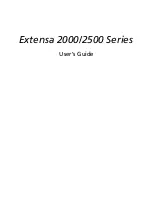
User’s Manual
Glossary-3
Glossary
cache memory:
High speed memory which stores data that increases
processor speed and data transfer rate. When the CPU reads data
from main memory, it stores a copy of this data in cache memory.
The next time the CPU needs that same data, it looks for it in the
cache memory rather than the main memory, which saves time.
The computer has two cache levels. Level one is incorporated into
the processor and level two resides in external memory.
capacity:
The amount of data that can be stored on a magnetic storage
device such as a floppy disk or hard disk. It is usually described in
terms of kilobytes (KB), where one KB = 1024 bytes and
megabytes (MB), where one MB = 1024 KB.
CardBus:
An industry standard bus for 32-bit PC cards.
CD-ROM:
A Compact Disc-Read Only Memory is a high capacity disc that
can be read from but not written to. The CD-ROM drive uses a
laser, rather than magnetic heads, to read data from the disc.
CD-R:
A Compact Disc-Recordable disc can be written once and read
many times. See also CD-ROM.
CD-RW:
A Compact Disc-Read/Write disc can be rewritten many times.
See
also CD-ROM.
character:
Any letter, number, punctuation mark, or symbol used by the
computer. Also synonymous with byte.
chip:
A small semiconductor containing computer logic and circuitry for
processing, memory, input/output functions and controlling other
chips.
CMOS:
Complementary Metal-Oxide Semiconductor. An electronic circuit
fabricated on a silicon wafer that requires very little power.
Integrated circuits implemented in CMOS technology can be tightly
packaged and are highly reliable.
compatibility:
1) The ability of one computer to accept and process data
in the same manner as another computer without modifying the
data or the media upon which it is being transferred. 2) the ability of
one device to connect to or communicate with another system or
component.
components:
Elements or parts (of a system) which make up the whole
(system).
configuration:
The specific components in your system (such as the
terminal, printer, and disk drives) and the settings that define how
your system works. You use the HW Setup program to control your
system configuration.
control keys:
A key or sequence of keys you enter from the keyboard to
initiate a particular function within a program.
controller:
Built-in hardware and software that controls the functions of a
specific internal or peripheral device (e.g. keyboard controller).
CPU:
Central Processing Unit. The portion of the computer that interprets
and executes instructions.
Summary of Contents for Satellite M70
Page 1: ...User s Manual M70 ...
Page 18: ...xviii User s Manual ...
Page 22: ...xxii User s Manual ...
Page 26: ...xxvi User s Manual Preface ...
Page 52: ......
Page 64: ...3 12 User s Manual Getting Started ...
Page 96: ...4 32 User s Manual Operating Basics ...
Page 105: ......
Page 106: ......
Page 110: ......
Page 118: ......
Page 156: ...9 18 User s Manual Troubleshooting ...
Page 164: ...B 6 User s Manual Display Modes ...






































